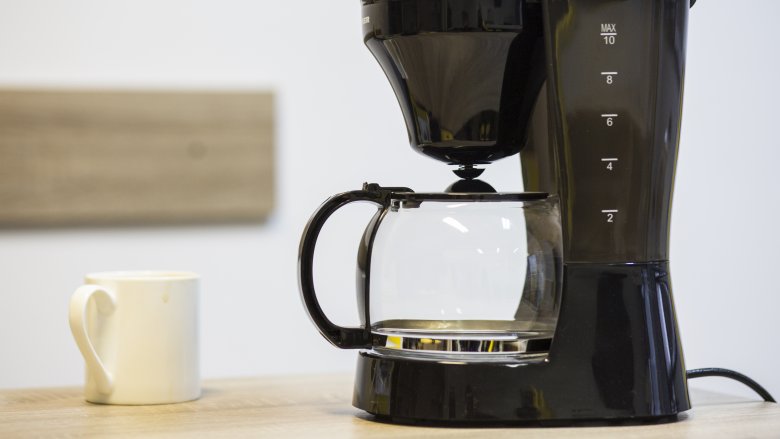The Reason You Need To Clean Your Coffee Maker Immediately
If it's been a while since you cleaned your coffee maker — or you've never cleaned it — you might want to do so before you pour that next cup of joe. Why? Because it's likely become a breeding ground for mold that is simply getting fired up every morning and ruining your coffee. According to a 2011 household germ study by product testing outfit NSF International, yeast and mold was found in 31 percent of households, and 50 percent of those homes had moldy, yeasty coffee makers. In fact, the reservoir of the coffee maker was the fifth germiest thing in the homes, after predictably gross items like sponges and pet food bowls.
Of course, some coffee makers are just a little more gag-inducing than others. In August 2019, one Redditor had travelers swearing off hotel coffee forever when they shared a photo of the disgusting mold-filled reservoir in their room, saying, "And this is why you check the hotel coffee maker before you use it..." Even if your's doesn't look like it has been growing something since the Jurassic era, it's still probably long overdue for a solid cleaning. "If you use your coffee maker every day, it should get a good cleaning about once per month," author and cleaning expert Beth McGee, told Eat This, Not That. "Coffee grounds leave residue in the brew basket, and water stains and bacteria can collect in the brewing components."
Alright, so now that the case has been made for why you should drop whatever you're doing at this very moment to clean your coffee maker, it's time to outline how to go about it. Good Housekeeping recommends that any removable parts be cleaned with soapy water, just like you would a dish. This means the basket the coffee grounds go in, as well as the pot itself. It's also probably a good idea to clean the warming plate while you're at it.
As for the inner parts of your coffee maker, fill the reservoir with half white vinegar and half water. Turn the pot on like you're going to brew a pot of coffee, but turn it off when it's halfway full. Allow it to sit for a half an hour to remove any mineral build up. After about 30 minutes, turn it back on to finish brewing and then pour it out. Finally, rinse the pot out and brew a full pot of water to finish the cleaning.
If you happen to have a Keurig, it's mostly a repeat of the same process with a vinegar/water mix, though the company also sells its own cleaning tools.
Not only will cleaning your coffee maker prevent you from regularly drinking mold, but you'll also have a better-tasting cup of coffee to enjoy. What's not to like about that?
